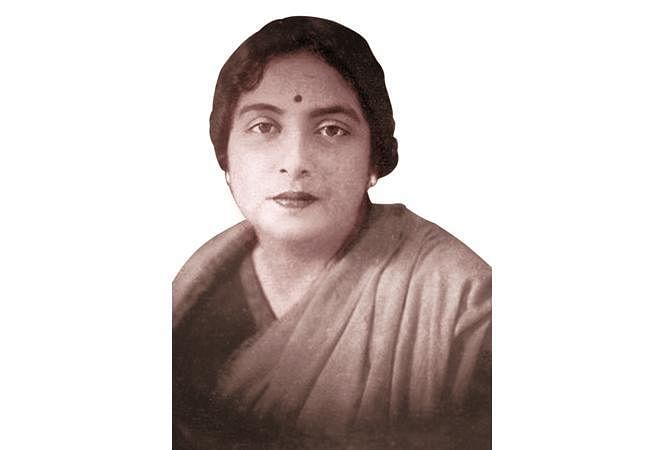
November 1 is the day that Karnataka remembers its celebrated people. But one noteworthy name has slipped away from public memory, almost without a trace. This is a case of historical amnesia, not just of Karnataka, but of India at large. Kamaladevi Chattopadhyay, freedom fighter and more, was born in Mangaluru, and her remarkable life journey included significant contributions to society -- as a social reformer, a feminist, the creator of ‘Faridabad’ for craftsmen who migrated from Pakistan, a tireless activist who revived Indian handicrafts, handlooms and theatre, and as the founder of many post-independence institutions of repute.
Kamaladevi was born in April 1903 in a liberal Chitrapur Saraswat Brahmin family in Mangalore (now Mangaluru). She completed her primary education at the local St Ann’s Convent. Growing up in a land with a rich cultural heritage, especially of the music and dance form Yakshagana, she developed a taste for traditional art forms. After her father’s untimely death, Kamaladevi moved to her maternal uncle’s house. There, she met renowned freedom fighters, including Gopalkrishna Gokhale, Srinivasa Shastri, Ramabai Ranade and Annie Besant.
Kamaladevi was married off at the age of 14 and widowed two years later. Unperturbed by these life events, she joined Queen Mary’s College in Madras (now Chennai) for higher studies. There, she met Sarojini (Chattopadhyay) Naidu’s brother Harindranath Chattopadhyay. Their mutual love for theatre led to their wedlock. Though widow remarriage was quite a rare phenomenon during those days, Kamaladevi rebelled against societal constraints. The couple travelled across the country, producing plays and skits. Later, she accompanied Harindranath to London and enrolled for a diploma at Bedford College. However, their marriage ended over incompatibility issues and this, too, created history – Kamaladevi’s was the first legal divorce granted through an Indian court of law.
Kamaladevi played a prominent role in political reforms and India’s freedom struggle. She was the first woman to contest the Madras provincial elections. Though she lost by a narrow margin, she got recognition and was appointed secretary of the All-India Women’s Conference. She joined Indian National Congress in 1927 and was elected to the All-India Congress Committee within a year.
During the Salt March to Dandi, she convinced Gandhi to give women equal opportunity to be in the forefront of the march. Later, she joined Seva Dal and trained women activists. However, the British government banned Seva Dal and threw Kamaladevi into jail. There, she contracted jaundice. Having experienced the pathetic condition of the prison hospital, she built a hospital for inmates upon release. Kamaladevi got attracted to socialism and took up the problems of labourers and peasants.
During World War II, she visited America and met several political activists, mostly blacks, and shared with them India’s non-violent approach to freedom struggle. The British got wind of her activism and banned her from returning to India. Unmoved, Kamaladevi continued on her journey, visiting South Africa, China, Japan and Vietnam.
Kamaladevi was inarguably the embodiment of women’s empowerment. She was an advocate of female sexual freedom and birth control. Her remarriage after widowhood and legal divorce from her second marriage were symbolic of her self-empowerment. She acted in many films (a Kannada film, too) when the film industry was not considered a respectable place for women. Nor do we know of another globetrotting Indian woman of her generation. Asked by a journalist her views on women’s empowerment, she replied, “Let men learn to be equal to women first.” Truly, she lived her life to the full, rare for women in her times.
Indeed, Kamaladevi’s immense travel and experiences shaped her as a secular, socialist world citizen. Such were her ideals that led to her building the city of Faridabad to rehabilitate some 50,000 craftsmen who moved to India from Pakistan during Partition. Post-independence, she helped revive Indian handicrafts and built institutions for a ‘New India’-- to name a few, the National School of Drama, Bharatiya Natya Sangha, Lady Irwin College, Sangeet Natak Academy, Central Cottage Industries Emporium, World Craft Council, Craft Council of India, and the Delhi Craft Council.
Kamaladevi was a prolific writer, too. She wrote 18 books altogether, touching upon women’s issues, Indian handicrafts and her foreign visits. She published her autobiography, “Inner Recesses, Outer Spaces: Memoir” (1986). She received several awards in recognition of her public service, like Padma Bhushan and Padma Vibhushan, the Ramon Magsaysay Award and the UNESCO Award. She died in Mumbai on October 29, 1988, aged 85.
Kamaladevi was ahead of her times, and she would perhaps be so even today. A woman of substance, she remained a mystery to the traditional Indian mindset. We speak of great national traditions, but we forget many who are true builders of post-independence India. Sadly, Kannadigas, too, have failed to remember this great daughter of the soil.
(The writer is Assistant Professor, Tumkur University)